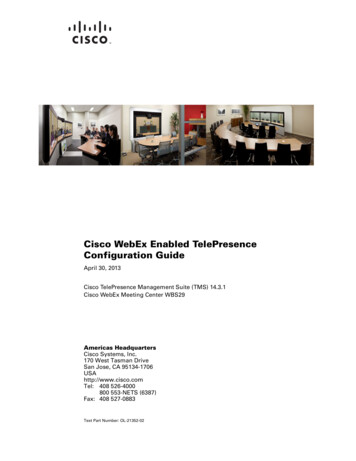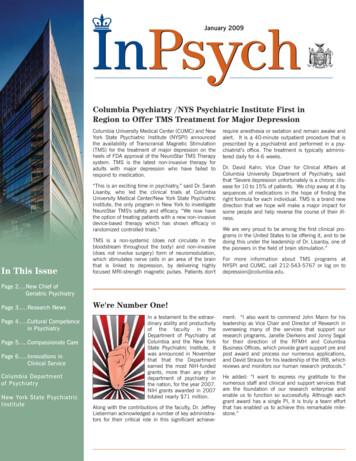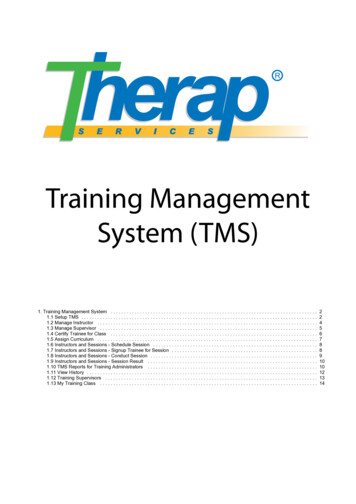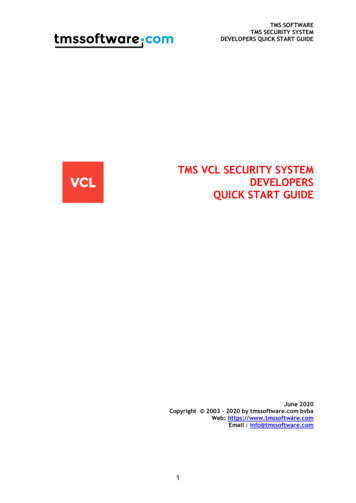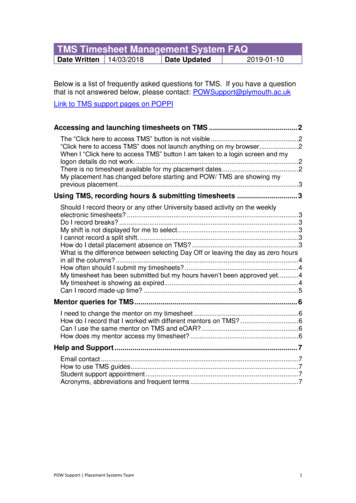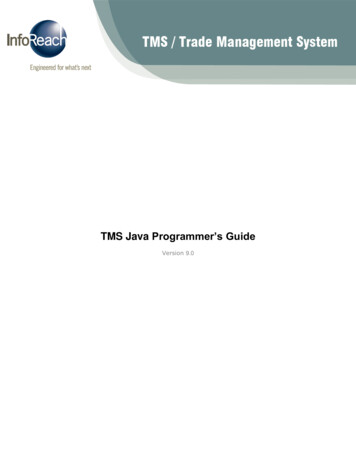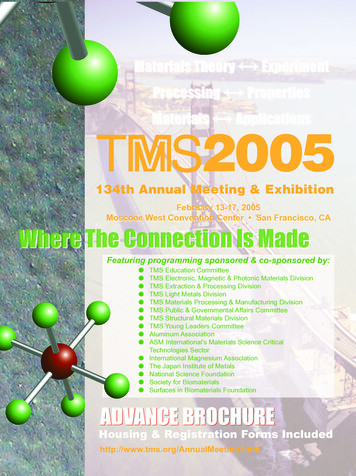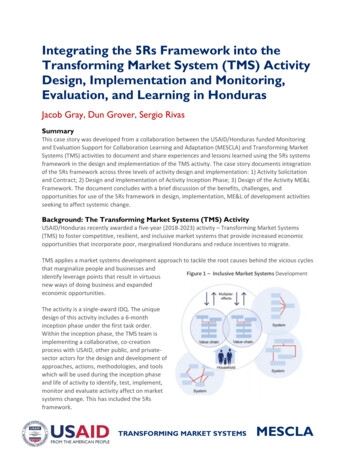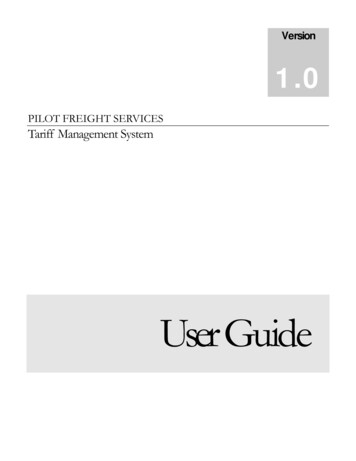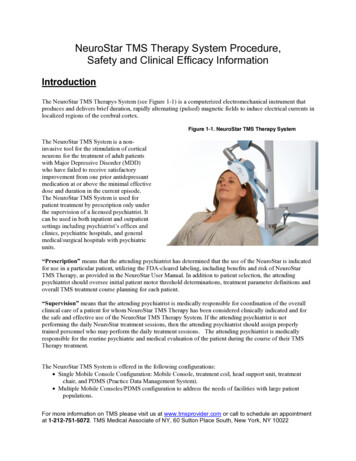
Transcription
NeuroStar TMS Therapy System Procedure,Safety and Clinical Efficacy InformationIntroductionThe NeuroStar TMS Therapy System (see Figure 1-1) is a computerized electromechanical instrument thatproduces and delivers brief duration, rapidly alternating (pulsed) magnetic fields to induce electrical currents inlocalized regions of the cerebral cortex.Figure 1-1. NeuroStar TMS Therapy SystemThe NeuroStar TMS System is a noninvasive tool for the stimulation of corticalneurons for the treatment of adult patientswith Major Depressive Disorder (MDD)who have failed to receive satisfactoryimprovement from one prior antidepressantmedication at or above the minimal effectivedose and duration in the current episode.The NeuroStar TMS System is used forpatient treatment by prescription only underthe supervision of a licensed psychiatrist. Itcan be used in both inpatient and outpatientsettings incOXGLQJ SV\FKLDWULVW¶V RIILFHV DQG clinics, psychiatric hospitals, and generalmedical/surgical hospitals with psychiatricunits.³3UHVFULSWLRQ means that the attending psychiatrist has determined that the use of the NeuroStar is indicatedfor use in a particular patient, utilizing the FDA-cleared labeling, including benefits and risk of NeuroStarTMS Therapy, as provided in the NeuroStar User Manual. In addition to patient selection, the attendingpsychiatrist should oversee initial patient motor threshold determinations, treatment parameter definitions andoverall TMS treatment course planning for each patient.³6XSHUYLVLRQ means that the attending psychiatrist is medically responsible for coordination of the overallclinical care of a patient for whom NeuroStar TMS Therapy has been considered clinically indicated and forthe safe and effective use of the NeuroStar TMS Therapy System. If the attending psychiatrist is notperforming the daily NeuroStar treatment sessions, then the attending psychiatrist should assign properlytrained personnel who may perform the daily treatment sessions. The attending psychiatrist is medicallyresponsible for the routine psychiatric and medical evaluation of the patient during the course of their TMSTherapy treatment.The NeuroStar TMS System is offered in the following configurations:Single Mobile Console Configuration: Mobile Console, treatment coil, head support unit, treatmentchair, and PDMS (Practice Data Management System).Multiple Mobile Consoles/PDMS configuration to address the needs of facilities with large patientpopulations.For more information on TMS please visit us at www.tmsprovider.com or call to schedule an appointmentat 1-212-751-5072. TMS Medical Associate of NY, 60 Sutton Place South, New York, NY 10022
OverviewSince the NeuroStar TMS System produces a time varying magnetic field, its intended effect derivesIXQGDPHQWDOO\ IURP )DUDGD\¶V /DZ ZKLFK DVVHUWV WKDW D WLPH-varying magnetic field produces an electricalcurrent in an adjacent conductive substance. During TMS, the conductive substance of interest is the brain, inparticular the region of the cortex that lies beneath the NeuroStar TMS System coil.The electric current induced in this region of thecortex travels in a path orthogonal to thedirection of the alternating magnetic field withthe point of maximum field strength and greatestcurrent located directly beneath the center of thecoil, which is the NeuroStar TMS SystemFRPSRQHQW WKDW UHVWV DJDLQVW WKH SDWLHQW¶V KHDG DQG WUDQVPLWV PDJQHWLF SXOVHV WR WKH SDWLHQW¶V brain. The induced current is tangential to thescalp at the cortical surface, and diminishes inmagnitude with increasing depth. In the targetedarea of the motor cortex, where field strengthachieves the stimulation threshold, it ispostulated that neuronal depolarization occurs.This type of magnetic field is not intended toinduce a seizure during therapeutic use. Thepeak magnetic field strength achieved with eachpulse in the cortex is approximately 0.5 Tesla.Although the mechanism of action is unknown, it is hypothesized that the NeuroStar TMS System causesneuronal depolarization and changes in brain functional activity that may be associated with variousphysiologic changes in the brain associated with symptomatic relief of depression in the indicated population.IndicationsNeuroStar TMS Therapy is indicated for the treatment of Major Depressive Disorder in adult patients whohave failed to achieve satisfactory improvement from one prior antidepressant medication at or above theminimal effective dose and duration in the current episode.Clinical TrialsThe safety and efficacy of NeuroStar TMS Therapy in Major Depressive Disorder (MDD) was studied in arandomized controlled trial of patients who had failed to receive benefit from one to four prior antidepressantmedications. While effectiveness was not demonstrated for the overall study population (N 301 patients,P 0.057 on the primary efficacy endpoint, MADRS change from baseline at 4 weeks of treatment), aretrospective subgroup analysis of the overall study population demonstrated that the device was safe andeffective for patients who had failed one, but not more than one, antidepressant medication (N 164 patients,P 0.0006 on the primary efficacy endpoint, MADRS change from baseline at 4 weeks of treatment). Efficacyof the NeuroStar TMS System was not established for patients who have failed to receive satisfactory clinicalimprovement from two or more antidepressant medications given at or above the minimal effective dose andduration in the current episode See Table 1-1.For more information on TMS please visit us at www.tmsprovider.com or call to schedule an appointmentat 1-212-751-5072. TMS Medical Associate of NY, 60 Sutton Place South, New York, NY 10022
1Pvalue represents the contrast between active and sham treatment conditions at the primary efficacy timepoint (week 4, LOCF analysis).The retrospective subgroup analysis was based on a six-week randomized, sham-controlled clinical trial inoutpatients, ages 18 to 70 years, meeting DSM-IV diagnostic criteria for MDD who failed to achievesatisfactory improvement from one prior adequate antidepressant medication in the current episode and whowere moderately to severely symptomatic. The majority of patients in this (ATHF1) subgroup ( 97%) hadrecurrent courses of major depression with the duration of the current episode of depression of 3 years.Patients had received a median of 4 total prior antidepressant medication attempts in the current episode, oneof which achieved treatment adequacy at or above the minimal effective dose and duration.In clinical trials, medication adequacy was determined using the Antidepressant Treatment History Form(ATHF), which identified those medications given at or above the minimal effective dose and duration asdefined in the product labeling. Failure of benefit was defined as no more than a minimal clinical response tothe antidepressant medication as assessed by the clinician. In cases where patients were untreated orinsufficiently treated in the current episode, the medication history from the most recent prior episode wasutilized to determine medication adequacy.A major depressive episode as defined in the DSM-IV implies a prominent and relatively persistent (nearlyevery day for at least two weeks) depressed or dysphoric mood that represents a change from previousfunctioning, and includes at least five of the following nine symptoms, one of which is either of the first twosymptoms:Depressed moodMarkedly diminished interest or pleasure in usual activitiesSignificant change in weight and/or appetiteInsomnia or hypersomniaPsychomotor agitation or retardationFatigue or loss of energyFeelings of worthlessness or excessive or inappropriate guiltSlowed thinking or impaired concentrationRecurrent thoughts of death or suicidal ideation or a suicide attempt.For more information on TMS please visit us at www.tmsprovider.com or call to schedule an appointmentat 1-212-751-5072. TMS Medical Associate of NY, 60 Sutton Place South, New York, NY 10022
NeuroStar TMS Effectiveness1,2Clinical trials have proven the effectiveness of NeuroStar TMS Therapy in treating patientswith major depression who have not benefited from prior antidepressant medication.* In clinicaltrials NeuroStar TMS Therapy was studied in adult patients suffering from Major DepressiveDisorder, all of whom had not received satisfactory improvement with previous antidepressantmedication.In clinical trials, indicated patients had been treated with a median of four antidepressantmedication attempts, one of which was at an adequate dose and duration.Neurostar TMS Therapy is indicated for the treatment of Major Depressive Disorder in adultpatients who have failed to achieve satisfactory improvement from one prior antidepressantmedication at or above the minimal effective dose and duration in the current episode.NeuroStar TMS Therapy has not been studied in patients who have not received priorantidepressant treatment. Its effectiveness has also not been established in patients who havefailed to receive benefit from two or more prior antidepressant medications at minimal effectivedose and duration in the current episode.A n E ffective O ption for T reating M ajor Depressive DisorderIn a controlled clinical trial comparing active treatment with the NeuroStar TMS Therapy system to an inactive device, patients treated with active NeuroStar TMS Therapy experienced a22.1% average reduction of their depression symptoms, compared to a 9% average reduction ofdepression symptoms in patients receiving inactive treatment.1Patients treated with NeuroStar also experienced significant improvement in anxiety andphysical symptoms (such as appetite changes, aches and pains, and lack of energy) associatedwith depression.2In a study most like real world clinical practice where all patients received active treatment,approximately half of the patients treated with NeuroStar TMS Therapy experienced significantimprovement in their depression symptoms. About a third of the patients treated with NeuroStarTMS Therapy experienced complete symptom relief at the end of six weeks.2NeuroStar T MS T herapy Safety3Clinical trials have proven the safety of NeuroStar TMS Therapy in treating depressed patientswho've had an inadequate response to prior antidepressant medications.Treatment with NeuroStar TMS Therapy caused few side effects and was generally welltolerated by patients. The most common side effects reported during clinical trials were headacheand scalp pain or discomfort ² generally mild to moderate and occurring less frequently afterthe first week of treatment.For more information on TMS please visit us at www.tmsprovider.com or call to schedule an appointmentat 1-212-751-5072. TMS Medical Associate of NY, 60 Sutton Place South, New York, NY 10022
Fewer than 5% of patients discontinued treatment with NeuroStar TMS Therapy due to adverseevents.O ver 10,000 active treatments were performed across all NeuroStar clinical trialsdemonstrating its safetyNo seizuresNo systemic side effectso No weight gaino No sexual dysfunctiono No sedationo No nauseao No dry mouthNo adverse effects on concentration or memoryNo device-drug interactionsThere is a low risk of seizure with TMS Therapy. The estimated risk of seizure under ordinaryclinical use is approximately 1 in 30,000 treatments (0.003% of treatments) or 1 in 1000 patients(0.1% of patients).Patients should be carefully monitored for worsening symptoms, signs or symptoms of suicidalbehavior and/or unusual behavior. Families and caregivers should also be aware of the need toobserve patients and notify their treatment provider if symptoms worsen.NeuroStar TMS Therapy should not be used (is contraindicated) in patients with implantedmetallic devices or non-removable metallic objects in or around the head. NeuroStar TMSTherapy should be used with caution in patients with implants controlled by physiologicalsignals. This includes pacemakers and implantable cardioverter defibrillators (ICDs).Contra- indicationsThe NeuroStar TMS System is contraindicated for use in some situations as identified below and furtherdescribed in Volume 2, Section 2. All patients must be screened for the following contraindications.Implanted Electronic Devices and/or Conductive ObjectsThe NeuroStar TMS System treatment coil produces strong-pulsed magnetic fields, which can affect certainimplanted devices or objects. The magnetic field strength diminishes quickly with increasing distance from thecoil. Within 30 cm of the face of the treatment coil, the peak magnetic field can be greater than 5 Gauss, whichis the recommended static magnetic field exclusion level for many electronic devices.Non-Removable Metallic Objects in or near the HeadThe NeuroStar TMS System is contraindicated for use in patients who have conductive, ferromagnetic, orother magnetic-sensitive metals implanted in their head or are non-removable and within 30 cm of thetreatment coil. Examples include cochlear implants, implanted electrodes/stimulators, aneurysm clips or coils,stents, and bullet fragments. Failure to follow this restriction could result in serious injury or death.Examples of metallic objects in or near the head that are acceptable under certain conditions include standardFor more information on TMS please visit us at www.tmsprovider.com or call to schedule an appointmentat 1-212-751-5072. TMS Medical Associate of NY, 60 Sutton Place South, New York, NY 10022
amalgam dental fillings, single post dental implants, and dental bridgework. The conditions for TMS treatmentwhen these objects are present are clarified in Volume 2, Section 2.WarningsAll users must consider the following warnings before proceeding to treatment.Risk of Ineffective TherapyPatients for whom NeuroStar TMS Therapy is indicated must have failed to receive satisfactory improvementfrom one prior antidepressant medication at or above the minimal effective dose and duration in the currentepisode. The Antidepressant Treatment Record (ATR) in AppendL[ VKRXOG EH XVHG WR UHFRUG D SDWLHQW¶V antidepressant treatment history to determine if NeuroStar TMS Therapy is indicated for use.T he efficacy of NeuroStar T MS T herapy has not been established in patients with major depressivedisorder who have failed to achieve satisfactory improvement from no antidepressant medications or 2or more antidepressant medications in the cur rent episode when administered at or above minimaleffective dose and duration. NeuroStar T MS T herapy has not been studied in patients who have had noprior antidepressant medication. T he A ntidepressant T reatment Record (A T R) should be used to recordD SDWLHQW¶V DQWLGHSUHVVDQW WUHDWPHQW KLVWRU\ WR GHWHUPLQH WKH QXPEHU RI SULRU PHGLFDWLRQ IDLOXUHV NeuroStar TMS Therapy has not been evaluated in patients with psychoses or with psychiatric emergencieswhere a rapid clinical response is needed, such as marked physical deterioration, catatonia, or immediatesuicide risk. Use of NeuroStar TMS Therapy in the treatment of these patients is not recommended since rapidonset of effect in these high-risk populations has not been established.Following use of NeuroStar TMS Therapy up to six weeks, patients will need to be monitored and may need toresume antidepressant medications. This device has not been evaluated for durability of antidepressant effect incontrolled clinical trials.Worsening Depression or SuicidalityPatients with Major Depressive Disorder may experience worsening of their depression and/or the emergenceof suicidal ideation and behavior (suicidality) or unusual changes in behavior, whether or not they are beingtreated with an antidepressant, and this risk may persist until significant remission of symptoms occurs.Observe patients undergoing treatment for Major Depressive Disorder closely for worsening symptoms andsigns of suicidal behavior and/or unusual behavior. If worsening of symptoms continues, consideration shouldbe given to changing the therapeutic regimen, including discontinuation of treatment with the NeuroStar TMSTherapy System. Families and caregivers should also observe patients and notify the treatment provider ifsymptoms worsen.Effects on Medical Devices Containing Electronics or Ferromagnetic MaterialThe NeuroStar TMS System should be used only with caution in the situations identified below. All patientsmust be screened for the conditions noted and appropriate cautionary measures should be taken.Implants Controlled by Physiologic SignalsThe NeuroStar TMS System should be used with caution in patients who have an implanted device that isactivated or controlled in any way by physiologic signals, even if the device is located outside the 30cmdistance. This includes pacemakers and implantable cardioverter defibrillators (ICDs). The device should beused with caution in patients using wearable cardioverter defibrillators (WCD). Failure to follow thisrestriction could result in serious injury or death.Implants Not Controlled by Physiologic SignalsPatients who have implanted devices or metallic objects located in areas outside the 30 cm distance from thetreatment coil may receive NeuroStar TMS Therapy. However, care must be taken by the NeuroStar TMSFor more information on TMS please visit us at www.tmsprovider.com or call to schedule an appointmentat 1-212-751-5072. TMS Medical Associate of NY, 60 Sutton Place South, New York, NY 10022
System operator to ensure that the treatment coil is never placed within 30 cm of these implants. Otherwise,serious injury could result. [Examples of these devices include staples, implanted insulin pumps, and vagusnerve stimulators (VNS).]Wearable or Removable Devices or ObjectsIf patients have removable devices or objects that may be affected by the magnetic field, the device(s) shouldbe removed from the patient area before treatment to prevent possible injury to wearer or damage to the device.(Examples include wearable monitors, bone growth stimulators, earrings, hearing aids, eyeglasses, jewelry,hair barrettes, cell phones, MP3 players, etc.)Use Near Magnetic Resonance Imaging (MRI) DevicesKeep the NeuroStar Mobile Console outside of MRI restricted access areas due to possible interaction with theMRI magnetic field.Metallic Object and Implant ChecklistPrior to treatment, each patient should be screened for the presence of metallic objects or implants that couldaffect the safe use of the NeuroStar TMS System. A list of items for which all patients should be screened isprovided in Volume 2, Section 2, Patient Selection, of this User Manual. This list summarizes compatibilityrequirements for devices and conductive objects in the vicinity of the NeuroStar TMS System treatment coiland provides guidance for whether the device is contraindicated for use or may be used if specificprecautionary measures are taken.Clinical WarningsAll users must consider the following clinical warnings before proceeding with patient treatment.Risk of SeizureGeneralized seizures have been reported with the use of TMS in the clinical trial literature. No seizures havebeen reported with use of the NeuroStar TMS System in over 10,000 treatment sessions in trials conductedprior to FDA clearance of the NeuroStar TMS System. Since the introduction of the NeuroStar TMS Systeminto clinical practice, seizures have been rarely reported. The estimated risk of seizure under ordinary clinicaluse is approximately 1 in 30,000 treatments (0.003% of treatments) or 1 in 1000 patients (0.1% of patients).Nevertheless, the NeuroStar TMS System should be used with caution in patients who have a history ofseizures, or a potential for alteration in seizure threshold, as stated below.In order to reduce the potential risk of seizure, observe the published 1998 National Institute of NeurologicalDisorders and Stroke (NINDS) Workshop report guidelines (Appendix C in this manual). Treatment withstimulation parameters that lie outside of these guidelines is not recommended.Be alert for signs of an imminent seizure and terminate the treatment session if those signs appear. If amedication that may alter seizure threshold has been taken since the last treatment session, the motor thresholddetermination should be repeated prior to the next treatment session. Patients at potential increased risk ofseizure include those who have:History (or family history) of seizure or epilepsy;History of stroke, head injury, or unexplained seizures;Presence of other neurological disease that may be associated with an altered seizure threshold (such asCVA, cerebral aneurysm, dementia, increased intracranial pressure, head trauma or movementdisorder);Concurrent medication use such as tricyclic antidepressants, neuroleptic medications, or other drugs thatare known to lower the seizure threshold;Secondary conditions that may significantly alter electrolyte balance or lower seizure threshold; andNo quantifiable motor threshold such that TMS dosage cannot be accurately determined.For more information on TMS please visit us at www.tmsprovider.com or call to schedule an appointmentat 1-212-751-5072. TMS Medical Associate of NY, 60 Sutton Place South, New York, NY 10022
CautionsAll users must consider the following cautions before proceeding with patient treatment.The effectiveness of NeuroStar TMS Therapy beyond a six-week treatment course for MDD.NeuroStar TMS Therapy administered as an adjunct to antidepressant treatment.The patient and the operator of the NeuroStar TMS System must always wear earplugs or similar hearingprotection devices with a rating of 30 dB of noise reduction during treatment. When used with appropriatehearing protection, NeuroStar TMS Therapy did not have an effect on auditory threshold.Longer-term effects of exposure to the NeuroStar TMS System magnetic field are not known. Experimentaland observational evidence indicates that exposure to the type of magnetic fields produced by the NeuroStarTMS System coil does not present any significant risk of acute or long- term adverse effects.Patients should be monitored for seizures, and seizure management procedures should be available.Special PopulationsThe safety and effectiveness of NeuroStar TMS Therapy has not been established in the following patientpopulations or clinical conditions through a controlled clinical trial.Patients who have failed to receive benefit from 2 or more antidepressant medications given at or aboveminimal effective dose and duration in the current episode or patients who have had no priorantidepressant medication failure.Patients who cannot tolerate withdrawal of antidepressant medications.Patients who have a suicide plan or have recently attempted suicidePatients who do not meet DSM IV criteria for major depressive disorderPatients younger than 22 years of age or older than 70 years of agePatients with history of substance abuse, obsessive-compulsive disorder or post-traumatic stressdisorder.Patients with a psychotic disorder, including schizoaffective disorder, bipolar disease, or majordepression with psychotic features.Patients with neurological conditions that include epilepsy, cerebrovascular disease, dementia, increasedintracranial pressure, having a history of repetitive or severe head trauma, or with primary orsecondary tumors in the CNS.Patients with metal in or around the head, including metal plates, aneurysm coils, cochlear implants,ocular implants, deep brain stimulation devices and stents.Patients with vagus nerve stimulators or implants controlled by physiologic signals, includingpacemakers, and implantable cardioverter defibrillators.Patients with major depressive disorder who have failed to receive clinical benefit from ECT* or VNS.Patients who are pregnant or nursing. *NeuroStar TMS Therapy has not been demonstrated to beequivalent inEfficacy to ECT for the treatment of major depressive disorder.For more information on TMS please visit us at www.tmsprovider.com or call to schedule an appointmentat 1-212-751-5072. TMS Medical Associate of NY, 60 Sutton Place South, New York, NY 10022
Procedure Warnings and PrecautionsRisk of explosion. Do NOT use the NeuroStar TMS System in the presence of a flammable anesthetic mixturewith air or with oxygen or nitrous oxide.Risk of electrical shock. Do NOT use the NeuroStar TMS System in or near water or other liquids, or placeliquids on or near the mobile console or any of the cables or coil.Risk of electrical shock. Do NOT open the panels of the NeuroStar TMS System mobile console. There areno user-serviceable parts in the system. If the system malfunctions, call Neuronetics for assistance.Do NOT place the NeuroStar TMS System near other medical equipment during operation. The effects of theNeuroStar TMS System on other equipment are unknown and could result in serious injury or death.Discontinue treatment with the NeuroStar TMS System in any patient who has a continued significant adversereaction or discomfort during or immediately after use. (Temporary mild discomfort at the site of stimulation isnormal during and/or shortly after treatment.),I WKH FRLO WHPSHUDWXUH ZDUQLQJ PHVVDJH LV GLVSOD\HG RQ WKH WRXFKVFUHHQ WKH SDWLHQW¶V VFDOS LV LQ FRQWDFW ZLWK D surface that may exceed 41 C. Clinical judgment should be used to determine whether or not treatment shouldcontinue for a patient with impaired ability to sense heat/pain. Patients who may be at increased risk of thermalinjury include patients with:Diabetes mellitusHistory of strokeUnder the influence of alcoholCurrent use of any sleep medication.To avoid injury and equipment or property damage, always install the gantry block in front of the gantry basewhen the mobile console needs to be moved from one location to another.Risk of chair tip-over. The NeuroStar treatment chair may tip over if excessive weight is applied to either theback support or the leg support when they are positioned near their horizontal positions. To avoid tip- over,make sure the patient is properly seated against the back support before elevating the leg support. Do not sit orstand on the footrest.Risk of pinching. Do NOT place fingers near the mechanisms under the treatment chair when it is beingoperated; injury could result. Observe the yellow warning triangles located in hazardous areas.A 10-minute interval between patient treatment sessions is required to guarantee that the coil operates withintemperature specifications. Failure to observe the 10-minute interval between treatment sessions could result inan unexpected system shutdown.Operate the NeuroStar TMS System only with parts and components provided and/or recommended byNeuronetics, Inc. The performance of the NeuroStar TMS System cannot be guaranteed if other parts orcomponents are used. Use of other parts may void the warranty.Do not place computer discs, audio recording tapes, credit cards, hotel room keys, or electronic automotiveignition keys on or near the coil while operating. The NeuroStar TMS System produces time varying magneticfields that may affect the integrity of data stored on these types of magnetic media if placed near an operatingcoil.For more information on TMS please visit us at www.tmsprovider.com or call to schedule an appointmentat 1-212-751-5072. TMS Medical Associate of NY, 60 Sutton Place South, New York, NY 10022
C lass 1 L aser C aution Use of controls or adjustments or performance of procedures other than thosespecified herein may result in hazardous radiation exposure.A Class 1 laser is incorporated into the A/P guide to assist in patient positioning. Although the laser meetsLQWHUQDWLRQDOO\ DFFHSWHG VWDQGDUGV WR EH ³VDIH WR H\H DQG VNLQ XQGHU DOO UHDVRQDEO\ IRUHVHHDEOH FRQGLWLRQV RI RSHUDWLRQ LW LV prudent to avoid prolonged or unnecessary exposure of the eye to the laser.Operation of the NeuroStar TMS System requires special precautions regarding electromagnetic compatibility(EMC). The system needs to be installed and put into service according to the following EMC information:Portable and mobile radio frequency communications equipment can affect the operation of theNeuroStar TMS System.Use of a power cord other than the one provided may result in increased emissions or decreased EMCimmunity of the NeuroStar TMS System.Do not use the NeuroStar TMS System adjacent to or stacked with non- medical equipment. If adjacent orstacked use is necessary, observe the NeuroStar TMS System to verify that it is operating normally.Adverse EventsThere were no deaths or seizures reported in NeuroStar TMS System clinical studies.The most common adverse events reported were application site pain and headache. Application site pain wasthe most frequently reported device-related adverse event with greater frequency in the active TMS treatmentgroup (35.8%) as compared to sham TMS (3.8%). Headache was reported by about half of patients and nearlyequally in both active TMS and sham TMS treatment groups. In general, application site pain and headachewere transient and dissipated rapidly with time. These adverse events were graded as mild to moderate inseverity for the majority of patients.For more details, see User Manual, Appendix B, NeuroStar TMS System Clinical Studies.Medical Event ReportingIf a medical event occurs that the prescribing physician considers to be related to treatment with the NeuroStarTMS System or a patient being treated becomes pregnant or experiences a seizure, these events should bereported to Neuronetics.Cognitive Function and Auditory ThresholdThere was no evidence of cognitive function testing change at either 4 weeks or 6 weeks associated with acutetreatment with the NeuroStar TMS System.There was no evidence of auditory threshold change at either 4 weeks or 6 weeks associated with acutetreatment with the NeuroStar TMS System (with use of 30 dB hearing protection during TMS treatment).Operator QualificationsFor more information on TMS please visit us at www.tmsprovider.com or call to schedule an appointmentat 1-212-751-5072. TMS Medical As
For more information on TMS please visit us at www.tmsprovider.com or call to schedule an appointment at 1-212-751-5072. TMS Medical Associate of NY, 60 Sutton Place South, New York, NY 10022 !! NeuroStar TMS Therapy System Procedure, Safety and Clinical Efficacy Information Introduction
